| کد مقاله | کد نشریه | سال انتشار | مقاله انگلیسی | نسخه تمام متن |
|---|---|---|---|---|
| 6445421 | 1640796 | 2016 | 13 صفحه PDF | دانلود رایگان |
عنوان انگلیسی مقاله ISI
Magnetostratigraphic age and monsoonal evolution recorded by the thickest Quaternary loess deposit of the Lanzhou region, western Chinese Loess Plateau
ترجمه فارسی عنوان
سن مغناطستراکتیوگرافی و تکامل انبساطی ضخیم ترین ضخیم ترین لایه کوه نوردی منطقه لانژو، افریقای غربی چین
دانلود مقاله + سفارش ترجمه
دانلود مقاله ISI انگلیسی
رایگان برای ایرانیان
کلمات کلیدی
موضوعات مرتبط
مهندسی و علوم پایه
علوم زمین و سیارات
زمین شناسی
چکیده انگلیسی
The loess-paleosol sequences of the Chinese Loess Plateau (CLP) are major paleoclimatic archives which document the evolution of the East Asian Monsoon (EAM) and changes in the Northern Hemisphere ice sheets during the Quaternary glacial-interglacial cycles. However, the mechanisms regulating the trend of EAM variations on a tectonic scale are unclear. The loess deposits of the western CLP, which have a close relationship with tectonics and climate, are much better-suited to exploring these mechanisms than those of the central CLP. However, studies of long-term EAM evolution from the western CLP have been hindered by the lack of long, accurately-dated sequences with high sediment accumulation rates. Here, we address this problem via high resolution magnetostratigraphic, magnetic susceptibility and grain-size analyses of a 416.2Â m-long drill core located at Xijin Village, near Lanzhou. Paleomagnetic dating indicates that the basal age of the Xijin loess is â¼2.2Â Ma. The Ï and grain-size records reveal that the East Asian Summer Monsoon (EASM) and East Asian Winter Monsoon (EAWM) strengthened synchronously at â¼1.24Â Ma. Subsequently, during interglacial periods, the EASM began to penetrate, and then dominate, in the Lanzhou region. This was followed by two stepwise uptrends, commencing at â¼0.87 and â¼0.62Â Ma, which resulted in an increasingly moist interglacial climate in the region. We suggest that the uplift of the Tibetan Plateau was largely responsible for these three stepwise enhancements of the EASM. Overall, however, the long-term trend of strengthening in EAWM in the area may have been primarily caused by long-term global cooling from the Late Pliocene onwards.
ناشر
Database: Elsevier - ScienceDirect (ساینس دایرکت)
Journal: Quaternary Science Reviews - Volume 139, 1 May 2016, Pages 17-29
Journal: Quaternary Science Reviews - Volume 139, 1 May 2016, Pages 17-29
نویسندگان
Jun Zhang, Jijun Li, Benhong Guo, Zhenhua Ma, Xiaomiao Li, Xiyan Ye, Hao Yu, Jia Liu, Cheng Yang, Shengda Zhang, Chunhui Song, Zhengchuang Hui, Tingjiang Peng,
